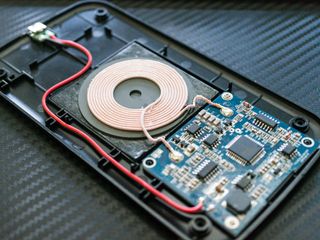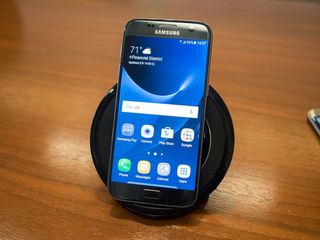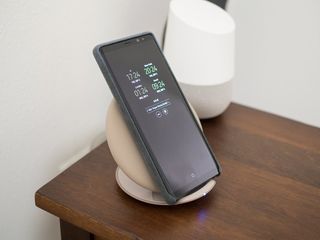What is wireless charging and how does it work?

Wireless charging, such as the Qi charging tech many Android phones use, isn't new technology. My Panasonic electric razor used it many years ago, and most of us have seen toothbrushes that charge wirelessly in a cradle. And of course, we can't forget Palm and the way it brought wireless charging to the masses with the Touchstone. Now that size, cost, and efficiency constraints have all eased up a little, putting wireless charging in something like your Android phone or watch makes more sense.
We get more than a few questions about wireless charging and how it works, so let's take a few minutes and talk about the basics; what it is, how it works and why you would want it in your next Android purchase.
More: The best wireless charging pads for Galaxy S8
What is wireless charging?

Wireless charging isn't magic — you still need a wire. The difference is that the wire is connected to a charging base instead of your phone, so you can just drop your Android onto the charger and things get to work without hooking anything up to your phone. The charging base can be almost any shape or size, and can even be in something like your car dash or the base of a lamp from IKEA. As long as you're able to get the right spot on the rear of your Android on the right spot on the base of the charger, it will work.
A good example would be having a wireless charging base on your desk at work. When you're not using your phone, you set it on the charger. When you need to use your phone, pick it up and it has a charge. Wireless charging isn't as fast as Quick Charge, but it's easy and something you're more likely to use to keep your phone topped off throughout the day (in our example). That's where wireless charging shines — ease of use.
How does wireless charging work?

Wireless charging uses two resonant inductive couplings to transmit low-power signals between two devices. These are specially designed to transmit electricity without touching each other like a normal wired connection does. The base station, which is plugged into the wall through its own power supply, has a transmitter coil and your phone has a receiver coil. The base station regularly sends a signal out, and when a receiver coil gets close enough, a resonance change (the base station changes the amplitude of its oscillation — it vibrates faster) happens in the signal. The waveform of the signal is then modulated (changed to let the coil in the phone know power is being sent) and inductive charging begins.
Wireless charging uses the same electrical theory as a generator: mechanical energy creates electrical energy.
Inductive charging uses those two specially designed electromagnetic coils to create a magnetic field between two devices. There is an intricate process involved that allows a magnetic field to produce electricity through the difference of potential and oscillation. Oscillation is a timed repetitive variation, and in the case of an electromagnetic coil, you can think of it as vibration.
Get the top Black Friday deals right in your inbox: Sign up now!
Receive the hottest deals and product recommendations alongside the biggest tech news from the Android Central team straight to your inbox!
The coil in your Android device is also connected to the battery charging circuit, and your battery is charged using the energy induced by the magnetic field.
Electromagnetic induction is really cool, and the basics are that if you move an electrically conductive material, like a coil or winding, in the presence of a magnetic field you make electrons flow. Things like a gas-powered generator also "create" electricity by using mechanical energy to create EMF (electromotive force). Electromagnetic induction is also used in transformers and current measuring devices.
Wireless charging isn't very efficient, but it is getting better with each iteration of the standard.
Excess heat is created as well, and that's part of why wireless charging isn't the most efficient way to transfer power from the wall to your battery. This is also why it takes longer to charge your phone on a Qi pad than it does to plug it into the wall. While new methods and materials use higher frequencies and thinner coils than past iterations, wireless charging is still less efficient and more costly than standard charging over a wire. It will stay this way for the foreseeable future.
To simplify:
- Your Android and the charger each have special electrical coils in them.
- When the two coils get close enough, they use magnetism to create small oscillations (vibrations) in the coil and an EMF is created by the coil inside your phone.
- This EMF sends a small amount of power through the charging circuit in your phone and charges the battery.
- It costs more and takes longer to charge than it would if you plugged your phone in, and creates more heat because this is less efficient than connecting wires the traditional way.
- Faraday's law of induction is awesome and the Maxwell–Faraday equation is like mathematical chocolate: sweet and decadent. Wireless charging is also pretty awesome when you're using it, too.
A word about Powermat

Qi is not the only wireless charging standard. Other standards like Powermat are used to build wireless charging solutions. These use a different standard than Qi but the science behind them all is the same. Powermat has partnered with companies like AT&T and Starbucks to provide base stations in public places, and using a special case or charging block attached to your phone lets you wirelessly charge. They are also partnered with General Motors and are working to bring built-in wireless charging bases in vehicles.
Powermat does some really great things (great if you're an electrical engineer, anyway) and some would argue that it's the better standard. In any case, Qi is more prevalent.
While the same basic electrical theory applies to both Powermat and Qi, the different standards mean they are not compatible. Your Qi-enabled phone won't charge on a Powermat base because the signals sent and received are different. If you have Powermat equipment, you'll need to be sure you're buying more Powermat equipment to get everything working.
There are exceptions, like Samsung Galaxy phones, which include both Qi and Powermat standards.
Why do I want wireless charging in my next phone?

Now that we have a widely accepted standard — we're talking the Qi standard here — we have to remember that any Qi charger will work with any device that is Qi-certified. That means the charger you buy, whether it's a $6 Chinese unbranded unit from Amazon or a name-brand like Samsung or Zens, will work with the device you have now and any devices you buy in the future.
You don't use wireless charging because it's "better". You use it because it's more convenient. A lot more.
Couple this with the convenience factor — and until you've bought a couple Qi chargers and put them in the places you're likely to set your phone you don't really understand how convenient it is. You might have a Qi charger at your desk, on the table in the living room, one in your car and one on your nightstand. Your Galaxy S8 will almost never have less than a 50% charge. Not because the battery life on the Galaxy S8 is great, or because Qi chargers work "better", but because whenever it's not in hand it's charging.
Of course, there's the initial cost of buying the charging bases, but they are pretty cheap — about the same cost as a good wall wart and USB cable. As more and more handheld devices and smartphones move towards the Qi standard, more and more devices will be able to take advantage of the chargers.
Wireless charging doesn't make your phone work any differently, but it can change the way you use it.
Update September 2017: Clarified some of the electrical theory and made sure the latest versions of the Qi standard were represented.

Jerry is an amateur woodworker and struggling shade tree mechanic. There's nothing he can't take apart, but many things he can't reassemble. You'll find him writing and speaking his loud opinion on Android Central and occasionally on Threads.